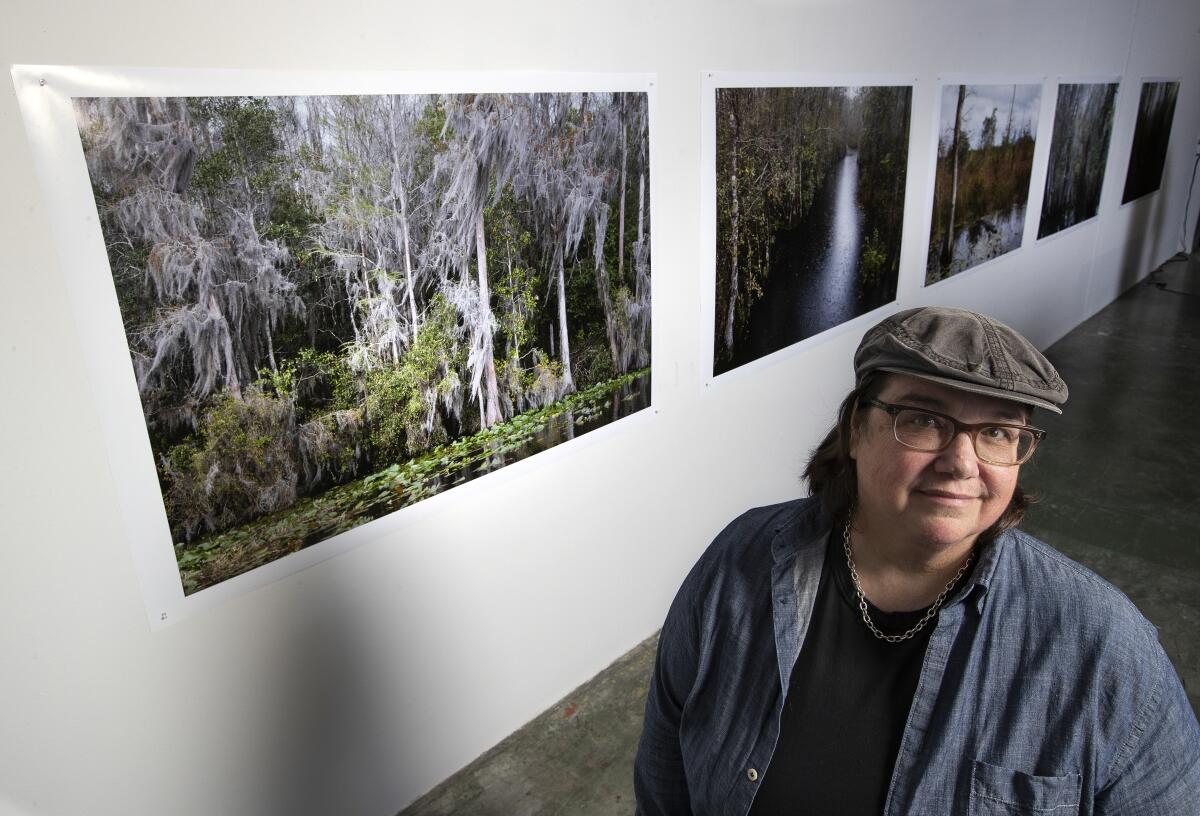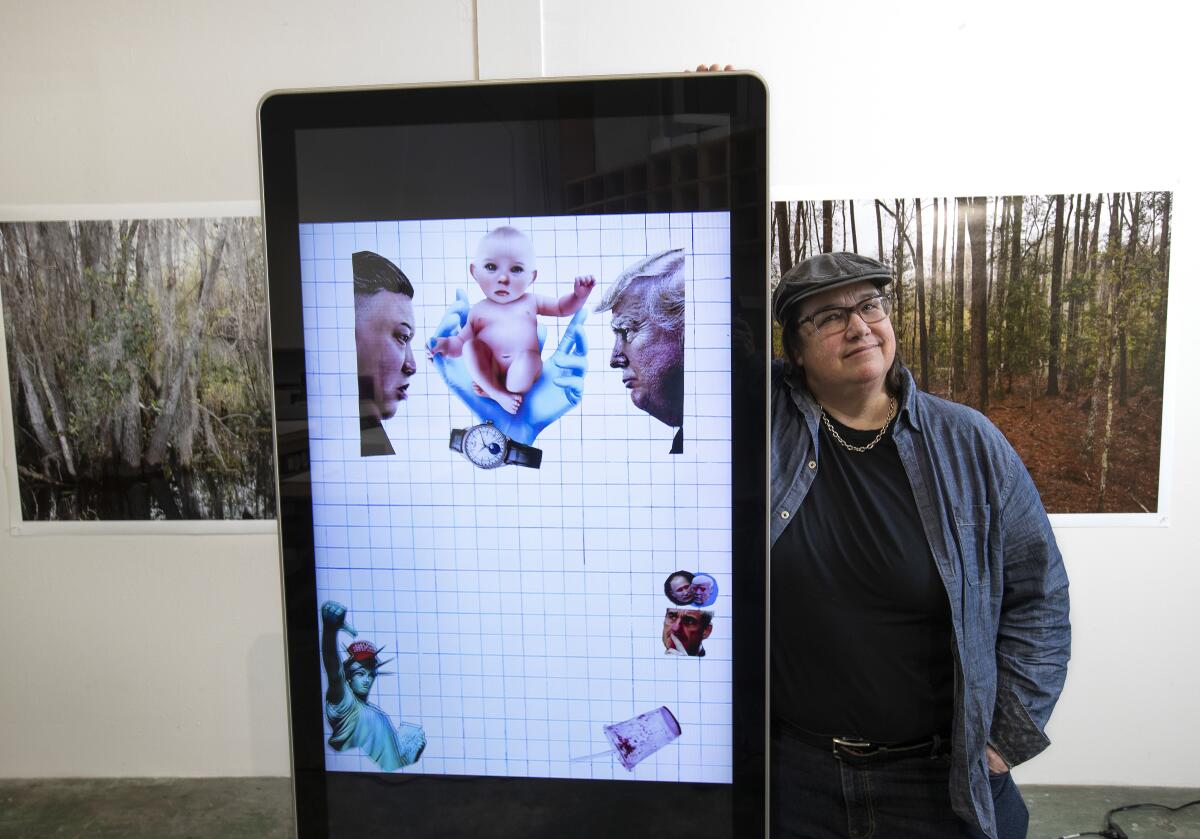‘Drain the swamp’? Artist Catherine Opie says swamps are beautiful

- Share via
To utter the word “swamp” is to evoke muck or morass. In comic books and Hollywood films, swamps are the watery abodes of slimy anthropomorphic monsters. In current events, the word serves as a shorthand for Washington politics, the sort of festering quagmire politicians of all stripes regularly threaten to drain.
Politics give swamps a bad name.
Swamps — or wetlands, as they are also known — are teaming hubs of biodiversity, serving as home to sturdy cypress trees, gracious wading birds and bubbling assemblages of microorganisms. These are landscapes that are “less about beauty than subtlety and originality,” writes journalist Michael Grunwald of the Everglades landscape in his 2007 book, “The Swamp.” “It was less ooh or aah than hmm. ... There was always more to the Everglades than met the eye.”
Los Angeles artist Catherine Opie is intrigued by swamps and what they obscure, not to mention the ways in which the word “swamp” can conjure both images of nature and internecine battles on Capitol Hill. There is “the rhetoric of ‘drain the swamp,’” she says, seated before a steaming cup of tea in her roomy Lincoln Heights studio, “but the swamp is also a beautiful, vulnerable ecosystem.”
Opie, 58, has, over the years, trained her camera in equal measure on people and landscapes — be it the intimates of her queer BDSM circles, or the vast expanses of steely California oceans bearing the diminutive silhouettes of shivering surfers. Now she has waded, literally and metaphorically, into the swamp.
The artist’s new series, “Rhetorical Landscapes,” on view at Regen Projects in Hollywood through April 4, features images of swamps made by Opie during a residency in Florida early last year. In these photographs, she captures inky waters, swaying mosses and the astonished face of an owl doing its best to fade into the vegetation. Also included in the show are new digital collages that bring together fragments she clips out of newspapers and magazines into vibrating stop-motion animations.
On a brisk afternoon early last month, Opie, who in addition to being an artist is also a longtime UCLA professor (late last year, she became the first to hold the art department’s endowed chair in art), took time to talk about how she ended up hanging out in the swamps — and the TV shows she likes to watch to get away from them.
How did you land on swamps as something you wanted to photograph?
I was asked to do a residency at the Atlantic Center for the Arts in New Smyrna Beach in Florida. It was February of last year. I had finished “The Modernist” [a multimedia installation about a fictional obsessive who torches Modernist architecture, also shown at Regen Projects]. And I was thinking about what it means to make political work that doesn’t hit you over the head with being political work. How can I make something that is meaningful at this moment in our country?
Which swamps did you visit?
I first went around areas in Florida that were driving distance from the area I was teaching. But they didn’t have the black-water swamp I was looking for. I liked the idea of the black bottom because of its reflection. I like not knowing what’s under the surface of the water.
It got to the point where I had one weekend left and I could go to the Everglades or I could go to Okefenokee. I liked the idea of Okefenokee because it’s so famous and it has had a role in the movies. That seemed like a landscape I could enter and I could make these pauses.

These [images] not only show the incredible beauty and thickness of the swamps, but they give us a break from the rhetoric of “drain the swamp.” The Spanish moss is beautiful. The colors — it goes from red to green to silvers. You have this foam that comes up from the bog, beautiful orchids, cypress trees. There are things that look like they are blowing in the wind because they are stuck in that direction. It has a sense of movement.
There is a lot of life in those swamps. At first, I thought I’d go in at night with a flash, then I realized how many alligators there were.
Why do you think swamps are so maligned?
My wife [Julie Burleigh] is from Louisiana, and I’ve spent the last 19 years going to Louisiana. It’s based on racism because it’s the South. It’s also class. Like saying, “They’re just a hick from the swamps.”
How does this series read to you in the wake of Trump’s impeachment and acquittal?
Looking at them, I think they activate in different ways. We have to ask ourselves what our relationship to vulnerability is and empathy and understanding — and a swamp contains all of that metaphorically. So I’m satisfied with the images. But I’m not satisfied with what’s happening politically. I’m actually pretty fearful. And I don’t usually live in fear — I try to be optimistic. Watching the State of the Union was really hard. We have a lot of hard work to do.
How do you prepare for shoots like this? Do you scout first or do you take the camera to see what unfolds?
Usually, when I immerse myself in a location, I tend to photograph every day. Get up and look every day, get up when the light is good and go out in the evening at that golden hour and think about what I’m looking for and what I want. I do a lot of driving and stopping. For these, I would take swamp tours and I would stand in line so that I could be at the front of the boat, so that I could seem to be alone in the landscape. That’s why I have good reflection, because it’s before the boat breaks the water.
The Resnicks have donated additional funds to help upgrade UCLA’s photo lab.
I always carry the camera. I do a lot of rolling down the window with my arm out, going down dirt roads. I’m constantly scaring anyone who is with me. I’m the person who pulls right off the road to make the picture. My students at the ACA were cracking up because we went to Cape Canaveral and I pulled to the median to photograph a rocket. [Elon] Musk was about to launch a rocket. They were like, “You’re going to pull over here?” I was like, “Yes, this is how you do it.”
You use a lot of found images in the animated collages you’re displaying at Regen.
In “The Modernist,” the character makes collages and so I had decided to investigate the notion of political collage. But I decided to engage it through stop-motion. They all deal with things in the news throughout the election of Trump. It all comes from magazines — cross-cultural American magazines, from House Beautiful to the NRA’s magazine to survivalist magazines.
In a box behind you, I cut out every photo in the L.A. Times that I deemed interesting. I put them in an envelope. Then I wanted to go back to the images as language, images as documentary. As Frederick Douglass said it, photography is our great democratic art.

We are at a moment in which we are saturated with images: on our phones, social media, TV. How do you practice photography in this environment?
You just realize you can’t be intimidated by the saturation. It has to be about your ideas — putting them forth in whatever body of work you might be conceiving. It’s a medium that I have spent my entire life thinking about and loving and, I have to trust in a certain way that I can still use that language. When people claimed painting was dead, it didn’t mean painters stopped painting.
What do you like to immerse yourself in as a break from politics — both geopolitics and art world politics?
I read two to three books a month. I really loved Jill Lepore’s book on America, “These Truths.” And I just finished “Americanah” [a novel by Chimamanda Ngozi Adichie], which I really liked a lot. I like the inner voice of the blog in that book. I recently asked my students, “Do you guys read blogs?” And they’re like, “No!” And I remember this whole moment in which the inner voice was through blogs. Now it’s through podcasts.
I also watch a lot of television. I stream a lot of different shows. After Thanksgiving, Julie and I streamed six seasons of “Downton Abbey” because we hadn’t seen it. I’m interested in the upstairs-downstairs thing. I watched “The Crown” and was thinking about what Meghan and Harry have done. I guess I’m a bit of a royal watcher, if I admit it. I am sitting here with my David Hockney cap on. And I have the last name Opie, which is very British.
'Catherine Opie: Rhetorical Landscapes'
Where: Regen Projects, 6750 Santa Monica Blvd., Hollywood
When: Through April 4
Info: regenprojects.com
More to Read
The biggest entertainment stories
Get our big stories about Hollywood, film, television, music, arts, culture and more right in your inbox as soon as they publish.
You may occasionally receive promotional content from the Los Angeles Times.












